Understanding Gastropods, Morphology, Classification, Characteristics, Structure
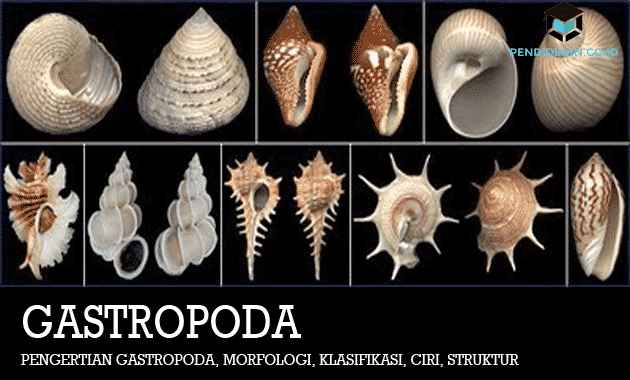
Understanding Gastropods
The word gastropod comes from the Greek words, namely gaster which means stomach and also podos which means foot. Gastropods themselves are also known as snails (naked snails), which are also included in the taxonomic class in the phylum Mollusca. This class includes all kinds of snails and also called naked snails with all kinds of sizes, from microscopic to large sizes. There are various species of sea slugs as well as naked sea slugs, as well as limpets, land snails, freshwater snails, and land naked snails.
So Gastropod means soft-bodied animal that walks by using its stomach. These animals include 50,000 species, but 15,000 of them are already or have become extinct. These animals are scattered all over the earth's surface, both on land, in fresh water, and also in sea water. In general, these animals have the nature of herbiphores, often eating cultivated vegetables so that it will harm humans.
Some gastropods have single, double shells, and some have no shells. The shape of the shell also varies, some are round, rough round, elliptical, or spiral round.
Gastropod morphology
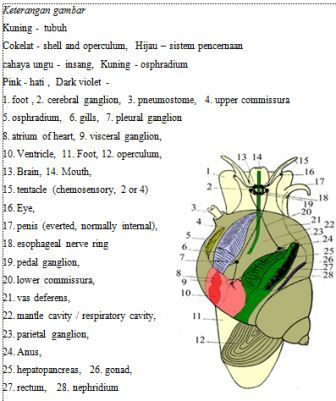
The morphology of this gastropod is manifested in the morphology of its shell. Most of the shell is made of calcium carbonate, which is coated with periostracum and horn substance on the outside. If the gastropod shell rotates backwards and then in a clockwise direction, it is known as dextral, and vice versa if the shell then rotates in a counterclockwise direction it is called sinistral. Gastropod snails that live in the sea are generally dextral in shape and very few are found in sinistral form (Dharma, 1988 in Handayani, 2006).
The growth of the spirally coiled shell was caused by the faster deposition of shell material on the outside than on the inside (Nontji, 1987 in Handayani, 2006).
This gastropod has an asymmetrical body with the mantle located at the front, the shell and the stomach contents are spiraled backwards. Location in the mantle on the back is what then makes a torsional movement or even rotation in the growth of the Gastropod snail. The torsion process also starts from the time of larval development (Dharma, 1988 in Handayani, 2006).
The general structure of this gastropod morphology consists of:
sutures, whorl, columella, posterior, outer lip, spiral sculptures, axial, posterior canal, aperture, operculum, longitudinal, sculpture, plaits on columella, anterior canal.
Gastropod characteristics

The main characteristic of this gastropod is that it has a single shell, so this class was previously referred to as a univalve. However, not all members of this class have shells. These shellless snails are also called naked snails; This animal has lost its shell due to the evolutionary process.
Animals in this class Gastropods usually have a head with 2 to 4 tentacles that function as chemical or mechanical receptors, with eyes at the ends. These soft animals also have legs on the ventral part. The very front leg is called the propodium which has a function to push sediment when the snail crawls.
Characteristics of this animal in that it obtains food with a rope-like structure or a rough tongue called a radula. This radula is often called a grated tongue, which consists of hundreds of microscopic teeth that are used to be able to scrape (grate) these foods such as algae and other food substances.
Classification of Gastropods
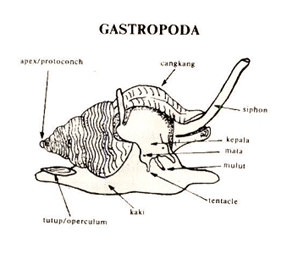
For now the classification of the Gastropod class (taxonomy) is also still undergoing a revision by Karna Modern taxonomy now wants to be more accurate in grouping these organisms according to their evolution (order DNA). Gastropod taxonomy is currently being reorganized to become monophyletic groups or groups. However, the old classification divides this class into four subclasses, including:
- The opisthobranchia are the gills on the right and behind the heart.
- This Gymnomorpha does not have a shell.
- Prosobranchs are gills in front of the heart.
- This pulmonata has lungs (no gills).
Gastropod Anatomy
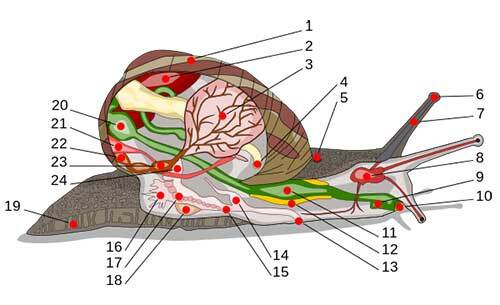
| Gastropod Anatomy | |||||||
|---|---|---|---|---|---|---|---|
| 1. | shell | 7. | tentacle (tentacles) | 13. | genital pore | 19. | feet |
| 2. | heart | 8. | brain ganglion | 14. | male sex | 20. | stomach |
| 3. | lungs | 9. | salivary duct | 15. | female sex | 21. | kidney |
| 4. | anal | 10. | mouth | 16. | mucus glands | 22. | coat |
| 5. | breathing pores | 11. | cache | 17. | oviduct | 23. | heart |
| 6. | eye | 12. | salivary gland | 18. | arrow bag | 24. | vas deferens |
Gastropod shell structure
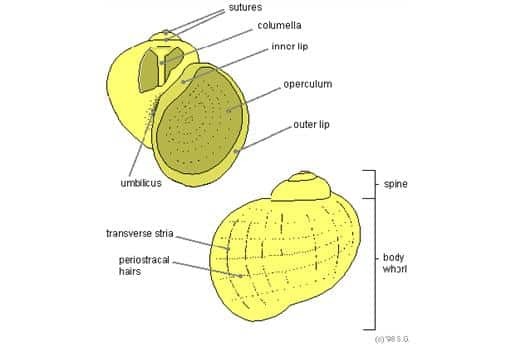
The shells of animals in this gastropod class have 3 main layers secreted by the mantle, including:
- Ostracum (en: ostracum): this is a calcareous layer in the middle. This layer is usually made of calcium carbonate.
- Periostracum (en: periostracum): this is an outer layer that is resistant to scratches, and also gives the shell color.
- Layer of nacres or layer of pearl (en: shell nacre): this is an inner layer that is finely textured and also in contact with the snail's body.
Gastropod Reproduction
Reproduction in this gastropod has many variations because this class consists of all kinds of snails that live in the sea, fresh water, and also on land. In land snails which are hermaphrodites (it has male and female sexes on one body), when two snails meeting, they were shooting “arrows” from the head of each other's bodies before a marriage. After that, each of the snails then begins to insert the male genitalia into the other female genitalia to fertilize the eggs. The eggs will be released into the ground, and after that hatch into snail larvae.
Gastropod Life Cycle
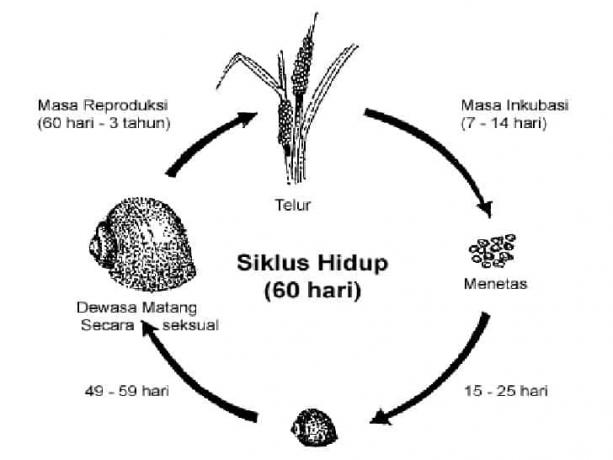
In general, the life cycles of animals in this class include:
- Snails lay eggs.
- Embryo development in eggs.
- The eggs hatch into larvae, which may or may not be trochophore or veliger larvae.
- Some types involve estivation as well as hibernation.
- The development of the young snail into an adult.
- Mating, it can or can be either external fertilization (ie generally species of sea slugs) or also internal fertilization.
Gastropod Shell Type
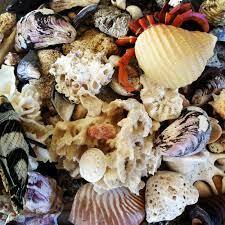
This gastropod shell type consists of 17 types including: conical, biconical, obconical, turreted, fusiform, patelliform, spherical, ovoid, discoidal, involute, globose, lenticular, obovatus, bulloid, turbinate, cylindrical and trochoid.
Things that need to be considered in observing and drawing shells are:
- Shell size: The length of the shell is measured from the anterior end of it to the posterior end. The width of the shell is measured from side to side at the widest part of the body world.
- The direction of rotation of the shell: It can also be determined by tracing the direction of rotation of the shell from the apex of the shell. If the direction of rotation is clockwise, it is called dextral, for example, as in Babylonia canaliculata. Conversely, if the direction of rotation of the shell is counterclockwise, it is called sinistral, for example, Amphidromus sp.
- Number of shell turns: Count it starting from the apex of the shell.
- Presence of an operculum: A shell that has an operculum is called an operculale, one that does not have an operculum is called a non-operculate. If there is an operculum, it should be drawn separately from the shell and given a type. There are three types of gastropod shell operculum, namely multispiral, paucispiral, and concentric (Siahaan, 2008).
Gastropod Body Structure
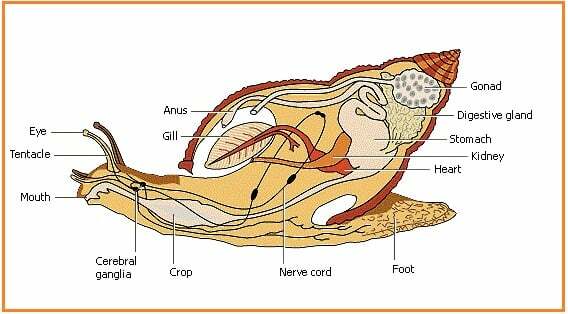
The body of the larvae is bilaterally symmetrical, but there is further development of the body parts the back as well as its internal organs had a bend it almost formed circle. Except for the naked snail or also known as Vaginula, all parts of the body These gastropods are protected by a 1-valve shell, hence the name univalve.
The snail's body consists of a head and a body. The structure of the head is clearly visible. In this section there are 2 pairs of tentacles and a mouth. The tentacles on the head consist of a pair of tentacles with eyes (especially for those who live on land) as well as a pair of tentacles for the sense of smell.
Gastropod respiration organs are gills for those who live in water and also lungs pulmonum for those who live on land. Apart from that, sometimes the mantle cavity can also perform the function of respiration. Pulmonum is a braid between blood vessels that are directly related to the heart.
This excretory tool is in the form of a kidney which is near the heart. These kidneys have excretory ducts that open into the mantle.
The gastropod nervous system consists of 3 pairs, including the visceral ganglion, pedal ganglion, and cerebral ganglion. Beneath the pedal ganglion are also a pair of balance devices or statocytes.
The body is divided into the head, neck, legs, and internal organs (visceral). On the head there are a pair of short tentacles that are used as a smelling tool and a pair of long tentacles as a tool of vision. Under the head there are mucous glands that produce mucus that moistens the feet so that it is easy for him to move. Feet wide flat and always wet which is useful for moving by creeping. The legs are actually the stomach which is composed of very strong muscles and can or can move in waves.
Most of these gastropods have a conical shell and usually it is threaded to the right. Inside the shell are internal organs that are threaded following the shell. The gastropod shell has the same constituent layers as the bivalve shell.
Gastropod organ systems

Respiration system in Animals that live in water yani respire with gills, while those living on land are respired by the mantle cavity which has a function as lungs.
Digestive system of food This digestive system includes the oral cavity, crop and esophagus as well as gastric glands as well as salivary glands and anus. The digestive tract is U-shaped. This food is cut into pieces by the jaws of the horns and chewed by the radula and moistened with mucus from the salivary glands. After that the food is swallowed into the esophagus and successively goes to the cache, stomach, and then is excreted through the anus in the head.
Examples of Gastropods
Examples of gastropods include the following:
- Vivipara javanica or kreco
- Limnaea truncatula (faciolosis intermediate snail)
- Ampularia ampulacea (gondang snail)
- Vivipara javanica (kreco)
- Acantina fulica (snail)
- Vaginula sp. (naked snail)
- Murex siphelinus (thorny graft and lives in the sea)
- Limnaea trunchatula (Snail as intermediate host of Fasciola hepatica)
- Filicaulis sp. (leech snail)
Thus an explanation of the Definition of Gastropods, Morphology, Classification, Characteristics, Structure, hopefully what is described can be useful for you. thank you
See AlsoUnderstanding Temperature, Change, Measuring Instruments, Types and Formulas
See AlsoDefinition of Social Media, Characteristics, Functions, Types and Impacts
See AlsoUnderstanding the Sun
